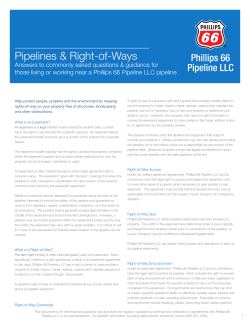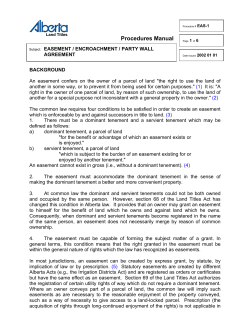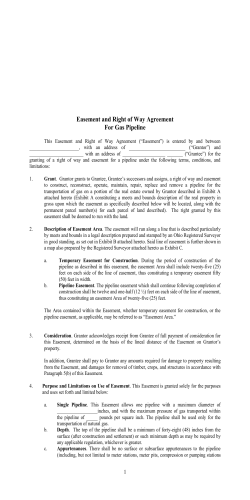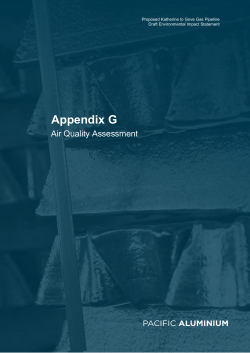
T APPRAISING PIPELINE EASEMENTS A Practical Approach
APPRAISING
PIPELINE EASEMENTS
T
A Practical Approach
BY GARY VALENTINE, MAI, ASA, SR/WA
he appraisal of pipeline easements is more difficult
than one might first assume. This is primarily due to
legal issues, partial interest, language used in the
easement agreement and scarcity of comparable
data. Appraisal assignments for pipeline easements
are generally classified into two categories: 1) new or proposed
pipeline easements; and 2) existing pipeline easements. Pipeline
easements are typically found in conforming size lots that are vacant
or improved, or as part of an existing transportation corridor.
Title acquired for pipeline use is most often acquired by
easements. This makes transferring the real property relatively easy
and free from delays. In addition, environmental studies are often
not required when transferring title for easements for pipeline use.
The fee owner remains the same, and property taxes are still paid
by the fee owner, unless agreed to otherwise, and title reports are
often not required, leaving disputed title issues in check. Much of
the railroad owned property was acquired through easements under
these circumstances, and some language in the easements require
the railroad to continue utilizing the property for “railroad
purposes.” Does installing a new pipeline preserve the railroad's
rights to continue utilizing the transportation corridor for
“railroad purposes?” These questions have not yet been clearly
answered by the courts.
20
R i g h t o f Wa y
MARCH/APRIL 2008
Leases are much like easements, except they have time restraints
and limitations.
Licenses are like leases, except they are most often used by governmental
agencies and are typically utilized for short term periods of less than one
year and are revocable, most often extended and easily renewed.
Scope of Assignment
To satisfy the scope of work for appraising pipeline easements, the
following steps are required:
• Identify the larger parcel (contiguity, use, and ownership)
• Identify the taking area for the proposed pipeline easement,
and identify placement and extent of the proposed pipeline
with the aid of an engineering map
• Review the proposed pipeline easement agreement
• Identify the proposed impact on vertical division, bundle of
rights and the highest and best use
• Apply the appropriate approaches to value
• Search for comparables
• Make appropriate adjustments
• Arrive at a final value opinion
Valuation of Pipeline as Part of Conforming Parcel
A conforming parcel is one where the site and all its improvements
thereon meet or exceed zoning code requirements for residential,
commercial, industrial or mixed use improvements. Furthermore, it
has adequate size, access, necessary depth, functional shape, and
overall functional utility.
In order to value a new pipeline within a conforming parcel, one
must first value the larger parcel, then value the part taken as part
of the whole by determining the value of the rights to be acquired.
This is done by estimating the percentage of the fee value through
analyzing the vertical division concept. Other ways of determining
the value of the part taken is by estimating its value using paired
data analysis, and finally by obtaining new studies and surveys.
Analyzing the value of each of the vertical divisions, including subsurface rights, surface rights and air rights, is very useful in
determining its value. In a high density area with high height limits,
the value of the air rights may be worth more than the surface and
sub-surface rights. In rural areas with low height limits for
structures, the surface rights may be the most valuable part. In
addition, there are multiple right occupancies as well. This is where
the pipeline encumbers multiple divisions, including parts of two or
three aspects of vertical rights, including sub-surface, surface and/or
air rights.
Paired Data Analysis
Paired data analysis is a quantitative technique used to identify and
measure adjustments that isolate a single characteristic's effect on
value or rent.
For example:
“Advance research and
preparation is the
best way to
ensure that the
appraisal is supportive
and reliable.”
Use Studies and Surveys
Interviewing buyers and sellers of property that is encumbered by
pipelines could be helpful in determining the pipeline's impact on
property value. Interviewing appraisers who are familiar with, and
who often accept such assignments, is also a good source for market
data. Reviewing published articles and books can provide significant
insight and examining recent case studies concerning the valuation
of pipelines or the sale of pipelines through testimonies, depositions
or exhibits can often reveal a treasure chest of market data.
Another way of obtaining market data is by sending out letters to
property owners whose sites are encumbered by pipelines, as they
can confirm rents obtained from a pipeline encumbering their
property, or recent sales of property used for pipelines. Other
important sources of data can be found through public agencies,
through the Freedom of Information Act concerning federal
agencies, and the State Records Information Act for each specific
state concerning local, county and state agencies. While the lower
level public agency employees may not be fully aware of what’s
available to the public, their supervisors are usually familiar with
public information acts.
Severance Damages
1) A typical 6.5-acre parcel without any encumbrances
recently sold for $50,000 per acre
2) Another 6.5-acre parcel with similar elements of
comparison to the previous sale sold with a 1⁄2
acre underground pipeline for $45,000 per acre
Calculation: (($45,000 / $50,000) - 1) = -10%
Therefore, adjust comparables downward 10% to
unencumbered comparable parcels since the subject is
encumbered similarly.
There are three specific reasons why severance damages may be
appropriate when analyzing the remainder parcel. They include:
1) change in highest and best use; 2) increased cost or restrictions
on existing uses; and 3) limits on future development or use.
Severance damages can be estimated by their estimated cost to cure.
However, appraisers will want to ensure that the cost to cure is not
added to the before and after analysis, as it may cause "double
dipping," also known as double counting for damages.
In utilizing the State Rule, benefits offset damages. For example,
better access to the subject site is possible along with superior
physical characteristics to the remainder in the after condition
MARCH/APRIL 2008
R i g h t o f Wa y
21
following the new construction. Likewise, superior utilities provided
to the subject site in the after condition is common with pipeline
improvements.
3. Estimate the ATF unit value of each zone without
considering the size, shape, access and terrain of the
subject corridor
In estimating just compensation per State Rule, the following
example may be useful.
4. Multiply the area of the transportation corridor in each
value zone by the ATF unit value
Value of Whole Property:
(5 acres @ $50/sq. ft.)
$10,890,000
5. Add the ATF value for each value zone together to equal
the total ATF value of the transportation corridor.
Standard Width for Pipeline Easement
Value of Part Taken:
(1 acre easement @ $50/sq. ft. x 40%)
$871,200
Value of the Remainder as Part of the Whole:
($10,890,000 less $871,200)
$10,018,800
Survey of Non-Exclusive Pipeline Easements
Value of the Remainder After the Take
((5 acres) (encumbered with 1 acre) @ $45/sq. ft.)
As part of the appraisal process, I often include surveys of private
companies and public agencies. The information I recently obtained
from one survey is as follows:
Width of
Easement
Required
$9,801,000
Damages
$217,800
Benefits
$100,000
Net Damages
$117,800
Total Just Compensation
$989,000
Gas Company
Transportation Agency
Railroad Company
Pipeline Company
County Sewer District
20 foot
10 foot
10-12 foot
5 foot
10 foot
% of Fee
Typically Paid
25% - 50%
25% - 50%
100%
50% (30% for 10-foot)
25%
Valuation of a New Pipeline as Part of the Existing Corridor
As described previously, a corridor is a long, narrow strip of land or
real property rights for which the highest and best use is to provide
an economic benefit by connecting the end points and sometimes
serving intermediate points along the way.
There are various methods that an appraiser uses to appraise
corridors. The most common include the Across-the-Fence (ATF),
Sales Comparison, Cost Approach, Net Liquidation Value and GoingConcern Value.
Since comparable sales of corridors are seldom available, the most
common method is the ATF methodology, which is first found in
the Interstate Commerce Commission (ICC) manual entitled
"Instructions Pertaining To Land Appraisals" dated April 1, 1918.
The five steps to using the ATF method are as follows:
1. Define the value zone of the corridor based on zoning and
uses of adjacent property
2. Search for comparable land sales for each of the value
zones
22
R i g h t o f Wa y
MARCH/APRIL 2008
This survey shows that there is no acceptable standard width for a
pipeline easement, as it is usually determined through negotiations.
Still, it may be helpful to understand the railroad's thought process
in setting their standard 10-foot wide widths for pipeline easements.
Initially, railroads arrived at the easement width by rounding up the
diameter of the pipe to the nearest foot. Then they added two feet
on both sides as a buffer to ensure the pipeline's integrity and
security, knowing that no other pipeline company would be
interested in placing their pipeline less than two feet from the
existing one. As such, the total width of the pipeline, assuming a
one-foot or less diameter pipeline, would be five feet (1 foot pipe +
2 feet on both sides = 5 feet).
Since then, the railroads have realized that pipeline users have been
getting free access onto their corridors to service and maintain their
pipelines. The railroads reasoned that since automobile lanes on
public roads are typically 11 to 12-feet wide, and given the width of
a standard truck, a 10 to 12-foot width requirement to access the
pipeline would seem reasonable. It is also reasonable to assume that
the additional width of the easement dedicated solely for access use
only should be charged at a lower rate. I call these areas the
"arterial zone" and the "fringe zone."
The arterial area is that area known as the buffer zone, whereas
no other pipelines or occupancy will be permitted (i.e., 2 feet
from both sides of the 8-inch pipeline = 5-foot wide arterial
(rounded)).
The fringe area is that area of the easement located outside the
arterial area and is less impacted by the pipeline. When
alternative means of access for maintenance is available, a fringe
area may not be required (i.e., 2.5 feet on both sides of the
arterial (2.5 + 2.5 = 5 feet of fringe area)).
Fair Market Rent
Having determined the market value of the proposed pipeline
easement, there are only a few more steps required for estimating
the fair market rent for a lease or license agreement. First,
determining the market land rate is necessary. This market land
rate is best extracted from the market using comparable sales.
Given the confidential nature of this information, these land rates
for pipelines and transportation corridors may not be available
(and we would not use land rates that are incompatible in the
highest and best use of the pipeline). So we may have to resort
to surveying private companies and agencies.
Through some recent research, I found the following information:
Sample Land Rates Survey
Public Transportation Authority 8% - 10%
Railroad Company
13% (including property taxes)
Pipeline Company
10% - 12%
County Sewer District
8% - 10%
However, what happens when the real property for the pipeline
runs along the public access road, where users of the pipeline can
maintain the pipeline by utilizing the public roadway, rather than
the railroad right of way? In this circumstance, the pipeline user
will likely not be utilizing the corridor for access to the pipeline.
Therefore, under these circumstances, consideration will be paid
for the arterial area only.
Upon calculating the diminution of the percentage fee within an
existing transportation corridor to the pipeline easement, and
assuming that the encumbrance of the arterial impacts the fee
rights by 60%, and the fringe impacts the fee rights by 30%, it is
calculated as follows:
Arterial:
Fringe:
5' / 10' x 60%
5' / 10' x 30%
30%
15%
Total percentage of fee encumbered
45%
Final Estimate of ATF Value
Through an in-depth analysis, an appraiser might arrive at a 10%
land rate as reasonable. Using the before-mentioned assumptions,
the fair market rent for the pipeline is as follows:
$22,500 (market value of pipeline) x 10% (land rate) =
$2,250 (rent annually)
As a side note, a relocation clause in a contract typically allows the
landowner to require the pipeline owner to relocate the line at any
time and for any reason at the cost of the pipeline owner. This
typically has no impact on the value of the pipeline. After interviewing
numerous railroad, utility, and private pipeline companies, owners of
corridors and underlying fee owners of pipelines, I found that they
seldom exercise this right.
Another important note is that severance damages are seldom
found for new pipelines in transportation corridors because
owners of corridors do not let pipeline companies install their
pipeline if it could diminish the value of the remaining portion of
the corridor. Even in eminent domain, it is beneficial for both
parties to work together to minimize damages.
Conclusion
Assuming the ATF unit value for the subject corridor is $50 per
square foot, and the pipeline encumbrance is 45% of the fee, and
the easement area equals 10-feet wide and 100-feet long
(totaling 1,000 square feet), the market value of the proposed
pipeline easement is as follows:
1,000 sq. ft. x $50/sq. ft. x 45% = $22,500
Advance research and preparation is the best way to ensure that
the appraisal is supportive and reliable. This entails adequate
attention up front, including identifying partial interests, language
in the easement agreement, conducting an in-depth search for the
best comparable data available and a thorough analysis. On the
contrary, if the scope of the assignment is not well defined and/or
not followed properly, the analysis and conclusions will be
misleading and unreliable.
MARCH/APRIL 2008
R i g h t o f Wa y
23
ABC’s of Real Estate Terminology for Appraising Pipelines
The following definitions are found in the Dictionary of Real Estate Appraisal, 4th edition:
Across-the Fence Method. A land valuation method typically used to estimate the value
of real estate corridor, including railroad or pipeline rights-of-way, highways, or other
corridor real estate. The price or value of land adjacent to the corridor ("across-thefence") is considered for the valuation. Other considerations include Corridor Factor and
Usage Factor adjustments.
Adjustments.
a. Mathematical changes made to basic data to facilitate comparison or
understanding. When dollar adjustments are used, individual differences
between comparables and the subject property are expressed in terms of
plus or minus dollar amounts; with percentage adjustments, individual
differences are reflected in plus or minus percentage differentials.
b. Items that should be prorated or apportioned between the purchaser and
seller in real estate transactions; e.g., taxes, rents, fuel.
Air Rights. The right to undisturbed use and control of designated air space above a
specified land area within stated elevations. Such rights may be acquired to construct a
building above the land or building of another, or to protect the light and air of an
existing or proposed structure of an adjoining lot.
Approaches to Value. Systematic procedures used to derive value indications in real
property appraisal.
Bundle of Rights. The concept that compares property ownership to a bundle of sticks,
with each stick representing a distinct and separate right of the property owner, e.g. the
right to use real estate, to sell it, to lease it, to give it away, or to choose to exercise all
or none of these rights.
Lease. A written contract in which the rights to use and occupy land or structures are
transferred by the owner to another for a specified period of time in turn for a specified
rent.
License. For real property, a personal, un-assignable, and typically revocable privilege or
permit to perform some activity on the land of another without obtaining an interest in
the property.
Liquidation Premise. One of the premises under which the total assets of a business
(TAB) can be valued; the assumption that a company will cease operations. Under the
liquidation premise, assets are valued as if sold piecemeal.
Paired Data Analysis. A quantitative technique used to identify and measure
adjustments to the sale prices or rents of comparable properties; to apply this technique,
sales or rental data of nearly identical properties are analyzed to isolate a single
characteristic's effect on value or rent.
Partial Interest. Divided or undivided rights in real estate that represent less than the
whole.
Pipeline Easement. The right to construct, operate, and maintain a pipeline over the lands
of others within prescribed geographical limits. The language of the easement determines
the extent of the rights granted.
Comparables. A shortened term for similar property sales, rentals, or operating expenses
used for comparison in the valuation process.
Sales Comparison Approach. A set of procedures in which a value indication is derived
by comparing the property being appraised to similar properties that have been sold
recently, then applying appropriate units of comparison and making adjustments to the
sale prices of the comparables based on the elements of comparison. The sales
comparison approach may be used to value improved properties, vacant land, or land
being considered as though vacant; it is the most common and preferred method of land
valuation when an adequate supply of comparable sales is available.
Conformity. The appraisal principal that real property values created and sustained when
the characteristics of a property conform to the demands of its market.
Scope of Work. The amount and type of information researched and the analysis applied
to an assignment. The scope of work includes, but is not limited to, the following:
Cost Approach. A set of procedures through which a value indication is derived from the
fee simple interest in a property by estimating the current cost to construct a
reproduction of (or replacement for) the existing structure, including entrepreneurial
incentive, deducting depreciation for the total cost, and adding the estimated land value.
Adjustments may then be made to the indicated fee simple value of the subject property
to reflect the value of the property interest being appraised.
• The degree to which the property is inspected or identified;
• The extent of research into physical or economic factors that could affect
the property;
• The extent of data researched; and
• The type and extent of analysis applied to arrive at opinions or conclusions.
Cost to Cure. The cost to restore an item of deferred maintenance to new or reasonably
new condition.
Double Counting.
a. In the process of estimating depreciation, accounting for a form of
depreciation more than once in the calculations of double depreciation, and
thereby over-estimating the impact of depreciation on real property value;
b. In the sales comparison approach, failing to separate the influence of
elements of comparison, and thereby making adjustments twice for the
same influence.
Final Value Opinion. The range of values or single dollar figure derived from the
reconciliation of value indications and stated in the appraisal report.
Functional Utility. The ability of a property or building to be useful and to perform the
function for which it is intended, according to current market taste and standards; the
efficiency of a building's use in terms of architectural style, design and layout, traffic
patterns, and the size and type of rooms.
Going-Concern Value. Includes tangible and intangible elements of value in a business
enterprise, resulting from factors such as having a trained workforce, an operational plant,
and the necessary licenses, systems, and procedures in place.
Highest and Best Use. The reasonably probably and legal use of vacant land or an improved
property, which is physically possible, appropriately supported, financially feasible, and that
results in the highest value. The four criteria the highest and best use must meet are legal
permissibility, physical possibility, financial feasibility, and maximum productivity.
Larger Parcel. In condemnation, the tract or tracts of land that are under the beneficial
control of a single individual or entity and have the same, or an integrated, highest and
best use. Elements for consideration by the appraiser making determination in this regard
are contiguity, or proximity, as it bears on the highest and best use of the property, unity
of ownership, and unity of highest and best use.
24
R i g h t o f Wa y
MARCH/APRIL 2008
Severance Damages. Generally used to mean those damages to a remainder property that
are compensable.
State Rule. In condemnation, the process of determining just compensation by
estimating the value of the portion to be acquired as part of the whole property plus
the net severance damages.
Sub-surface Rights. (1) The rights to the use and profits of the underground portion of
a designated property; usually refers to the right to extract coal, minerals, oil, gas, or
other hydrocarbon substances, as designated in the grant; may include a right-of-way
over designated portions of the surface. (2) The right to construct and maintain tunnels,
subways, sub-cellars, pipelines, and sewers, etc.
Surface Easement. The right to use the surface of land only, e.g., for access, flowage,
right of way; also called Surface Rights.
Taking.
a. The acquisition of a parcel of land through condemnation.
b. In land use law, application of police power restrictions to a parcel of land
that is so restricted as to preclude any reasonable use.
Title. The combination of all elements that constitute proof of ownership.
Transportation Corridor. A long, narrow strip of land or real property rights for which
the highest and best use is to provide an economic benefit by connecting the end points,
and sometimes serving intermediate points along the way. Most corridors provide these
connections for energy (oil and gas pipelines, electrical power transmission lines),
transportation (road, rail, aqueducts, channels, navigation, aircraft over-flight), or
communications (fiber-optic lines) purposes. Many corridors may or may not have a
highest and best use of continued corridor use.
Vertical Division. The division of real property into air, ground (surface), and
subterranean rights.
© Copyright 2025





















